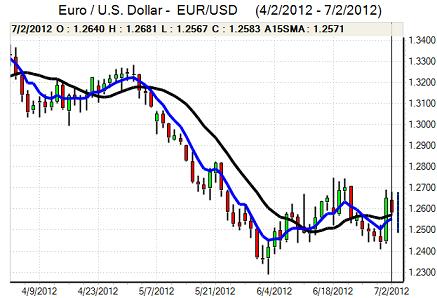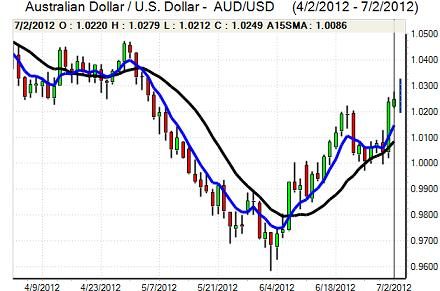EUR/USD
The Euro was unable to hold above the 1.2650 area against the dollar on Monday and retreated aback to lows below 1.26 later in the European session, although ranges were relatively narrow.
The Euro-zone data did not provide much impetus to the currency with the final PMI manufacturing index edging higher to 45.1 from a provisional 44.8 while unemployment was unchanged at 11.1%.
There was a more cautious tone surrounding last week’s EU Summit as uncertainties surrounding measures agreed started to increase. Finland and the Netherlands both indicated that they would block any ESM bond buying in the secondary market which had an important impact in undermining sentiment, especially with fears of wider political opposition. There were also doubts whether any form of banking union could be realised within the timeframe envisioned by EU leaders and any requirement for treaty changes could meet strong opposition.
Germany also remained a pivotal focus amid fears that any measures to increase support for peripheral economies would be met with increased domestic resistance. In particular, there were concerns that the Constitutional Court could block ESM ratification.
The latest US ISM manufacturing index weakened sharply to 49.7 for June from 53.5 previously and this was the first sub-50 reading since the third quarter of 2009. The Markit index remained comfortably above the 50 level, but there will be increased doubts over the manufacturing sector. The data will also increase unease surrounding the global economic outlook.
There was a deterioration in risk appetite following the data release and a decline in commodity prices which provided some underlying support for the US currency. Potential backing was offset by increased speculation that the Federal Reserve move towards additional quantitative easing. The Euro found support below 1.2570 and consolidated just below 1.26 in subdued Asian conditions.

Source: VantagePoint Intermarket Analysis Software
Call now and you will be provided with FREE recent forecasts
that are up to 86% accurate* 800-732-5407
If you would rather have the recent forecasts sent to you, please go here
Yen
After initially finding support just below the 78.50 level against the yen, the dollar was unable to make a fresh attack on the key 80.0 resistance level and retreated to lows below 79.50 later in the US session.
There was a significant decline in US Treasury bond yields on defensive grounds and following the weaker than expected US economic data which had an important impact in undermining the US currency.
The yen was unable to take full advantage and the US currency was able to move back towards the 79.80 area in Asian trading on Tuesday as regional equity markets rallied for the fifth successive session.
Sterling
Sterling found support on dips towards the 1.5650 level in Europe on Monday and pushed higher to test resistance above 1.57 before retreating modestly.
The latest UK PMI manufacturing index stayed below the 50 level for June even though there was an advance to 48.6 from 45.9 previously. The data maintained expectations that the Bank of England would expand quantitative easing at the latest policy meeting this Thursday as export markets struggle to provide any support.
Sterling, however, remained generally resilient during the day, as has been the general pattern over the past few sessions. There was further speculation that the UK currency was benefitting from safe-haven demand, especially as there was little in the way of domestic fundamental support. In this context, the UK currency again tested resistance above the 1.57 level with the Euro dipping to test 0.80 support.
Swiss franc
The dollar found support below the 0.95 level against the franc on Monday and rallied to the 0.950 area later in the US session. There was no relief for the Euro as it was trapped close to the 1.2010 level following the brief advance seen following the EU Summit.
National Bank Chairman Jordan maintained his insistence that the Euro minimum level would be sustained and that negative interest rates could not be excluded as a policy option. The latest PMI index remained below the 50 level for June, although there was a strong 6.2% annual increase in retail sales which will provide some degree of support for the currency.

Source: VantagePoint Intermarket Analysis Software
Call now and you will be provided with FREE recent forecasts
that are up to 86% accurate* 800-732-5407
If you would rather have the recent forecasts sent to you, please go here
Australian dollar
The Australian dollar hit resistance in the 1.0275 region against the US currency on Monday and edged down towards the 1.0230 level during the US session.
There was a decline in commodity prices during the session which had some negative impact on the Australian currency, especially as global growth doubts were increased by the weaker than expected US PMI reading.
The Reserve Bank of Australia left interest rates on hold at 3.50% following the latest policy meeting, in line with expectations and there was some degree of support for the Australian currency from a strong rise in building approvals with a renewed test of resistance near 1.0280.



